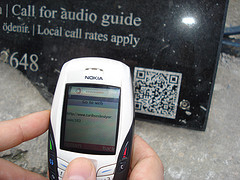 QR codes started with a buzz, but they never really picked up the steam they should have. What’s the problem? Are consumers simply not interested in scanning mobile bar codes?
QR codes started with a buzz, but they never really picked up the steam they should have. What’s the problem? Are consumers simply not interested in scanning mobile bar codes?
With so many people owning smartphones (expected to reach 58.3% penetration by 2014 in the United States), timely and useful QR codes would appear to be a fantastic marketing tactic. However, in 2014, it’s expected that just 15.7% of the U.S. adult population will use barcodes.
Even consumers who try using QR codes don’t use them more than once. During the third quarter of 2011, 60% of North American consumers who scanned QR codes did so only one time. That means QR codes have two problems: initial trial and repeat usage.
The problem to-date with QR codes is very simple if you listen to what consumers have to say about them. Brands aren’t offering the experiences from QR codes that consumers want. Why should consumers take time to scan a QR code if they don’t expect to get something of value in exchange for the effort?
As eMarketer reports, a September 2011 study (by the Association of Strategic Marketing) of U.S. marketers who used QR codes found that two out of three delivered QR codes provided product information to consumers. Less than one out of four QR codes delivered discounts, coupons, or savings.
Consumers want QR codes to offer discounts and freebies, but that’s not what brands are delivering. That’s the problem with QR codes, and usage won’t increase until consumers’ expectations for them are consistently met.
Specifically, eMarketer reports the following content that U.S. internet users would be interested in scanning QR codes for:
- To get discounts, coupons, free items: 43%
- To get more information about a product or service: 26%
- To get exclusive content: 25%
- To purchase or buy something: 23%
- To get more information about an event: 22%
- To get more information about a brand or company: 18%
Think of it this way — a QR code shouldn’t be any more interruptive to a consumer than it has to be. QR codes should add value and enhance consumers’ lives. Cluttering their lives with information they don’t need instantly won’t successfully encourage people to scan brand QR codes. However, a brand that learns how to deliver timely and useful information using QR codes, such as discounts, will develop a level of trust with consumers that will motivate those consumers to scan the brand’s QR codes again and tell their friends how great that brand’s QR codes are. Ultimately, that brand’s sales will go up.
Image: Brian Suda
Susan Gunelius is the author of 10 marketing, social media, branding, copywriting, and technology books, and she is President & CEO of KeySplash Creative, Inc., a marketing communications company. She also owns Women on Business, an award-wining blog for business women. She is a featured columnist for Entrepreneur.com and Forbes.com, and her marketing-related articles have appeared on websites such as MSNBC.com, BusinessWeek.com, TodayShow.com, and more.
She has over 20 years of experience in the marketing field having spent the first decade of her career directing marketing programs for some of the largest companies in the world, including divisions of AT&T and HSBC. Today, her clients include large and small companies around the world and household brands like Citigroup, Cox Communications, Intuit, and more. Susan is frequently interviewed about marketing and branding by television, radio, print, and online media organizations, and she speaks about these topics at events around the world. You can connect with her on Twitter, Facebook, LinkedIn, or Google+.


